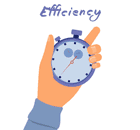How to Improve the Team Velocity in Scrum?
Team velocity in Scrum reflects the team's productivity and proficiency. Having a balanced team velocity leads to many benefits. So, stick with this guide to learn the best tips to improve the team velocity in Scrum.

Team velocity or Sprint velocity is an important metric in Scrum. It helps to track the efficiency and productivity of a Scrum team. Furthermore, it gives stakeholders a general idea of the team's capabilities and what to expect from them Sprint by Sprint. Ideally, a Scrum team should have a balanced team velocity that is neither slow nor fast. Therefore, this article will discuss some of the most effective tips and tricks to improve team velocity in Scrum, starting with a quick overview and its importance. So, let's begin our discussion.
Team Velocity in Scrum – A Quick Overview
A team velocity, Sprint velocity, or velocity is the quantitative measure of how much work a team can complete in a Sprint. Basically, the velocity is the average number of user story points the team is able to complete in a Sprint. For instance, if the team runs a four-week Sprint and executes 70 user story points, the team's velocity is 70.
The higher the team's velocity, the more work it can complete in a Sprint. In contrast, a lower team's velocity reflects that the team can only complete limited work. When a team's velocity begins to increase, it indicates that the team can now take more work per Sprint.
Team velocity is measured at the end of every Sprint and averaged with the previously measured velocities of past Sprints. This way, a Scrum team can continuously calculate its velocity and see where its work abilities stand as a team.
Why is Team Velocity Important to Measure in Scrum?
There is a mixed opinion on whether we should measure Sprint velocity or not. Some consider it positive, while others consider it anti-Agile behavior because organizations often use the metrics in negative dynamics.
Anyways, team velocity has many beneficial aspects for Scrum Teams. When you track how many backlog items you were able to deliver in the last Sprint, you can predict the capacity for the upcoming Sprint.
The low and high velocity also reflects important insights. A high velocity indicates that your team might unintentionally over-promise and get in trouble. Similarly, a low velocity indicates something wrong within the team that should be fixed. Therefore, team velocity is highly effective in determining the team's strength and improving its efficiency to deliver more quality products and keep stakeholders satisfied.
11 Tips to Improve the Team Velocity in Scrum
It is not uncommon to see Scrum teams struggling with Sprint velocity, especially the teams new to Scrum. So, we have shortlisted a few effective tips that can help your team improve the velocity without stressing out:
1. Regular Sprint Retrospectives
Sprint Retrospective is one of the main events of Scrum and an excellent opportunity for teams to improve velocity. In a Sprint Retrospective meeting, the team:
- Review the processes/practices of the finished Sprint.
- Discuss the good and bad of the Sprint.
- Find areas of improvement and create an action plan for the upcoming Sprints.
Sprint Retrospective is where the team can evaluate its Sprint velocity, compare it with the previous velocity, and discuss what are the reasons that might be impacting the velocity. So, when a Scrum team regularly conducts a Sprint Retrospective meeting, it will gradually improve the team's velocity through the joint efforts of every member.
2. Avoid Context Switching
Context switching happens when a person switches to a different work from the one he/she is currently doing. The other word for context switching is multitasking. However, this practice is less beneficial and more harmful.
When someone switches from one work to another, it takes away precious time and compromises focus and productivity. So, if multiple members in a Scrum team are in the context switching practice, it will impact the team's velocity. Therefore, try to enforce a no context switching policy and see the results.
3. Maintain a Constant Development Team
What will happen if a development team of seven members gets reduced to six members? It will definitely impact the team's velocity. Even if one member is replaced with a new one, the team's velocity will still be compromised.
It is recommended to keep a constant and same development team for all the Sprints of the project. However, if you have to replace a member, allocate that extra time in the Sprint to avoid complications later.
4. Reduce Work Item Size
Another effective practice to improve team velocity in Scrum is reducing work item size. The recommended practice is to break down any work item that takes over a week to complete. This will help to create smaller work units, which will become easier to execute and provide better workflow. So, a better workflow leads to improved team velocity.
5. Well-Planned Way to Manage Obstacles
Scrum teams often face obstacles or bottlenecks during Sprints. But the best teams are the ones that proceed with a well-planned way to manage obstacles. First, they conduct special product backlog estimation meetings using Async Poker, Planning Poker, or any estimation technique to estimate the efforts to complete user stories and pinpoint bottlenecks.

Async Poker for Jira

Sync Poker for Jira
Afterward, once they face any unexpected hurdle, they handle it through a well-planned approach, which not only emphasizes addressing the hurdle but also implements preventative measures to avoid it in the future. This way, such teams can manage obstacles proficiently and improve their efficiency and velocity.
6. Ensure Knowledge Transfer (Cross-training)
A Scrum team with one database engineer or designer is vulnerable to collapse if that crucial member goes on leave, becomes sick, or resigns. The team should have at least two members who know each other's work. For that, it is important to encourage a knowledge transfer or cross-training culture so that everyone gets to the same level. This way, your team will stop depending on each other and can improve the team's velocity significantly.
7. Avoid Comparing Velocity with Other Teams
Sprint velocity is different for different teams. The team size, members' experience, project complexity, and similar factors influence the team's velocity. So, comparing your team's velocity with other teams is not right. Set your own parameters for success and focus on improving your team's velocity over time.
8. Set Up a Common Definition of Done for Every Sprint
Consider that you asked your team member if a specific code is done. If he says yes, then whether it means the code is completed and tested or just completed. Therefore, it is important to have a clear "Definition of Done".
When a team has a mutually agreed DoD, the user story will only be declared "done" when all DoD checkboxes are ticked. This helps to increase process accountability, reduce technical debts, improve the team's velocity, and enhance quality.
9. Address Technical Debt
Technical debt is a set of incomplete works left off due to time constraints, delivery of urgent features, or other reasons. Besides that, practices like delaying bug fixes, postponing code refactoring, and neglecting proper documentation all come under technical debt.
Technical debt can directly or indirectly slow down the team's velocity. Therefore, you should work with your team and address technical debt promptly to reduce its impact on the team's velocity.
10. Try Out Pair Working
Pair working is a new emerging practice in which two team members work on the same code in real time. If one is writing the code, the other will be proofreading the code in real time. Pair working is believed to improve productivity and efficiency, leading to faster deliveries. In addition, it also helps to share skills and knowledge. Therefore, you should try pair working with your Scrum team and see how effective it goes for the team's velocity.
11. Training
All the above tips can help to improve the team's velocity, but the extra boost comes with proper training sessions. Some team members are not very experienced with Scrum or are unaware of best practices. Therefore, arranging training sessions can help educate team members, discuss tips and tricks to improve team velocity, and pinpoint new ways to enhance overall productivity.
Wrapping Up
Team velocity in Scrum is easy to measure but provides many valuable insights. It reflects how much work the team can take and also provides a perfect reflection of efficiency and productivity. Therefore, it is essential to have a balanced team velocity to ensure excellent execution of Sprints and quality deliveries. So, we will wrap up the discussion by recommending you follow the above tips to improve the team velocity and make your Scrum team more efficient and productive.




